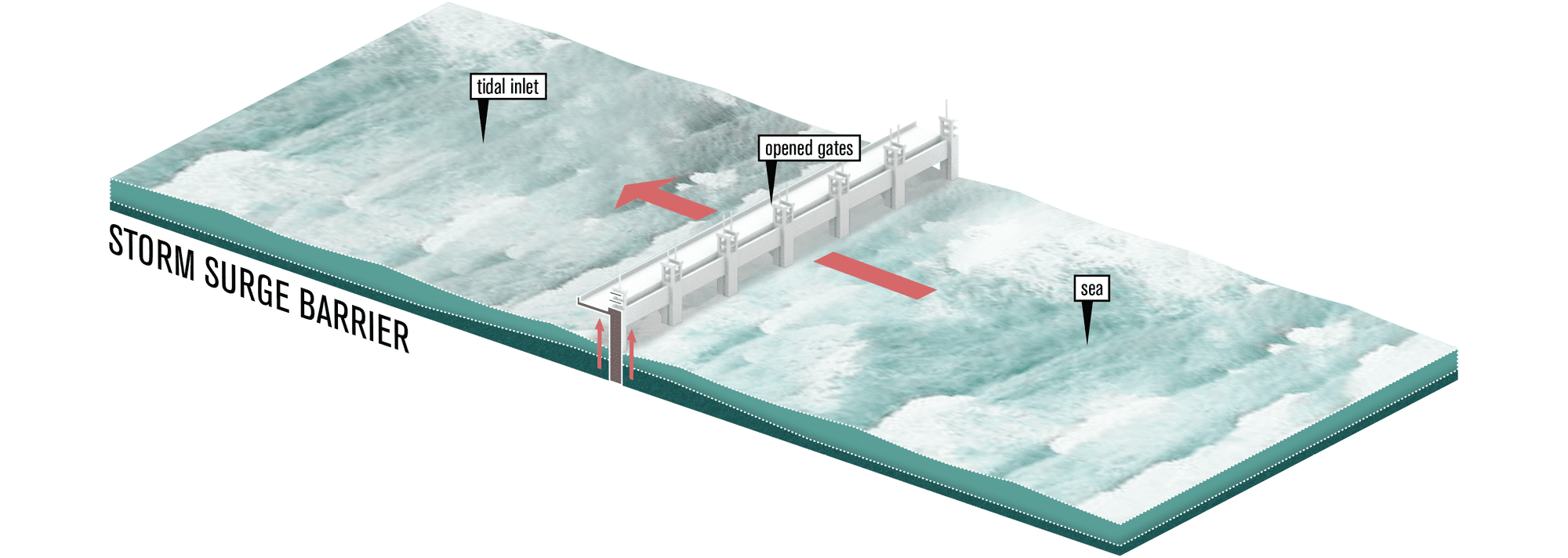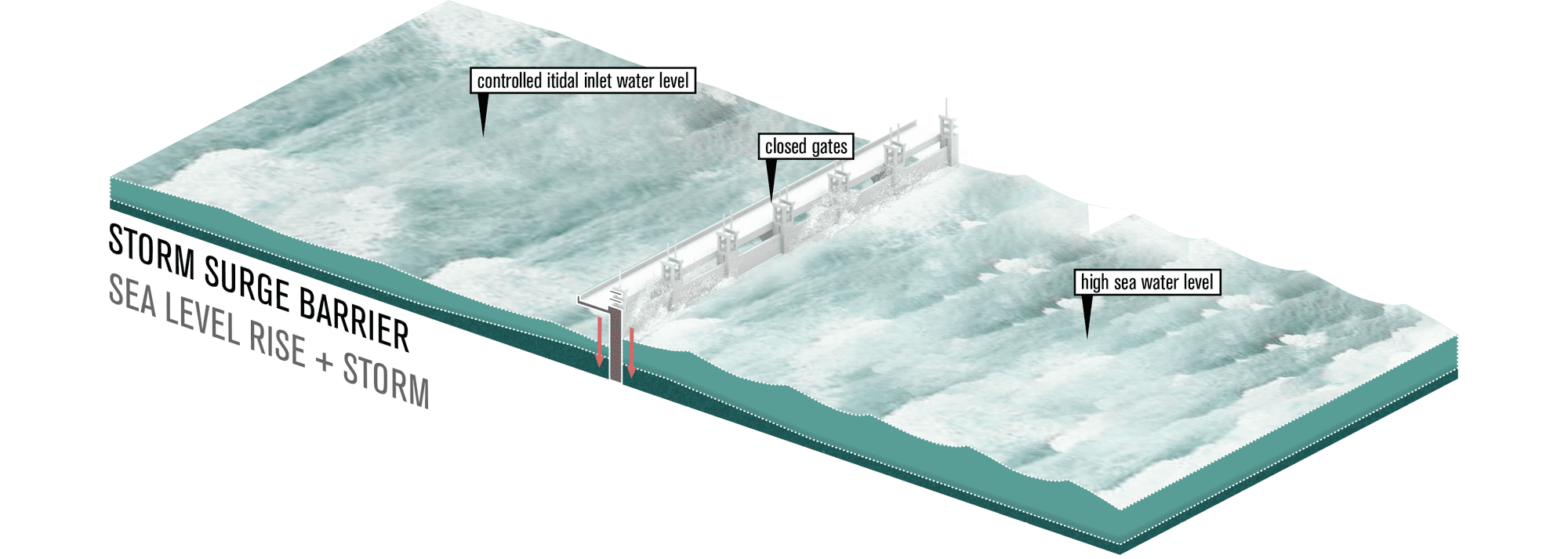Adaptation Strategy: Storm Surge Barriers
Storm surge barriers are heavily engineered movable or fixed barriers/gates that are closed to prevent flooding during bad weather forecasts.1 They are commonly located across the mouth of a tidal inlet or estuaries to control the water level and prevent excessive amounts of water from entering the estuary.2 Storm surge barriers can be very beneficial for secondary flood protection, on the landward side of the barrier. For example, storm surge barriers can reduce the maintenance and construction cost of secondary storm protection structures.3 Because these barriers require a high level of engineering feasibility studies and because they incur high construction costs, they can be challenging to implement as a cost-effective adaptation strategy. Additionally, storm surge barriers are more appropriate in areas with tidal lets that can be closed.4
How it works
Types of storm surge barriers
- Sector gates are radial structures comprising two gates with lateral support. Both the gates and arms create a section of a circle that turns around a vertical axis. The gates move based on the water pressure exerted against them.
- Mitre gates are flat gates that are comprised of two units. When the two units are closed, they lean against each other forming a wedge in the direction where the water level is highest.
- Swinging gates or barge gates are flat and rotate around a vertical axis at one side of a waterway. Swinging gates are designed to prevent tidal intrusions only in low water flow.
- Rotary segment gates are cylindrical segments that rotate around a horizontal axis. When a rotary gate is open, the barrier rests on a sill made from concrete that is embedded in the waterway. 12
Benefits
- Protects tidal inlets and estuaries from extreme wave events
- Reduces cost and maintenance of coastal flood defenses on the landward side
- Protects an entire bay area including ports.
- Can be utilized as a bridge or railroad link
- Provides infrastructure support for the development of derelict areas.
Example projects
La Planche River Aboiteau
Amherst NS, Canada
In 2015, the province of Nova Scotia awarded $5 million in the replacement of the old aboiteau on the La Planche River.8 An aboiteau is a one-way storm barrier that controls the flow of water through a dike.9 It is typically used to protect valuable assets such as marshland and agricultural land by reducing the amount of flooding during high tides or storm surges. The design and location of the new aboiteau were intended to reduce the maintenance of existing dikes and to increase the crest elevation to accommodate a rise in sea level.10 The new aboiteau is part of the 241 km of dikes and 260 aboiteau that are operated by the Agriculture Department, under the Marshlands Conservation Act. The act is intended to protect over 43,000 acres of Nova Scotia marshlands.11
Thames Barrier
London ENG, UK
The Thames Barrier is one of the largest movable storm surge barriers in the world. It was constructed in response to the frequent tidal surges that London experienced before the Flood Protection Act of 1972.5 Construction began in 1974 and the finished structure was put into operation in 1982.6 According to the Environment Agency, the Thames Barrier cost around £535 million to construct. The Thames Barrier is built to provide a high level of protection for several decades. In 2000-2001 there was an unusual number of closures. Then, it was projected that the trend will continue because of climate change and sea-level rise.7
Citations
-
1.
↑
Zhu, Xianli, et al., Technologies for Climate Change Adaptation - Coastal Erosion and Flooding. 2010, pp. 54. https://orbit.dtu.dk/files/5699563/Technologies for Climate Change Adaptation-Coastal Erosion and Flooding.pdf.
-
2.
↑
Ibid, 55.
-
3.
↑
Ibid, 57.
-
4.
↑
Ibid, 61.
-
5.
↑
Flooding in London. Greater London Authority, Nov. 2002, pp. 21. https://www.london.gov.uk/sites/default/files/gla_migrate_files_destination/archives/assembly-reports-environment-flooding.pdf.
-
6.
↑
Ibid, 21.
-
7.
↑
Ibid, 21.
-
8.
↑
Leys, Vincent, and Daniel Bryce. Adapting to Climate Change in Coastal Communities of the Atlantic Provinces, Canada: Land Use Planning and Engineering and Natural Approaches. Mar. 2016, pp. 63. https://research.fit.edu/media/site-specific/researchfitedu/coast-climate-adaptation-library/canada-amp-arctic/canada---atlantic/Leys--Bryce.--2016.--CC-in-Coastal-Communities-of-the-Atlantic-Provinces,-Land-Use,-Engineering-Natural-Approaches.pdf.
-
9.
↑
Ibid, 63.
-
10.
↑
Ibid, 63.
-
11.
↑
Cole, Darrell. “Colwell Announces $5-Million Aboiteau for LaPlanche River: Cumberland News Now.” News, 23 Sept. 2014, https://www.cumberlandnewsnow.com/news/local/colwell-announces-5-million-aboiteau-for-laplanche-river-30277/.
-
12.
↑
Deltares. Enabling Delta Life. Overview storm surge barriers. http://www.masterpiece.dk/UploadetFiles/10852/25/Deltares_2018_Overview_storm_surge_barriers_komprimeret.pdf
-
13.
↑
Esteban et al. (2019). Handbook of Coastal Disaster Mitigation for Engineers and Planners 2015, Pages 723-747. Chapter 33 - Adaptation to Sea Level Rise in Tokyo Bay: Opportunities for a Storm Surge Barrier? https://www.sciencedirect.com/topics/engineering/storm-surge-barrier
-
14.
↑
Climate Technology Center and Network. (nd). Storm surge barriers and closure damshttps://www.ctc-n.org/technologies/storm-surge-barriers-and-closure-dams
-
i1.
↑
Roberts, Andy. Thames Barrier. https://upload.wikimedia.org/wikipedia/commons/thumb/4/49/Thames_Barrier_03.jpg/1280px-Thames_Barrier_03.jpg.
-
i2.
↑
Figure 1. Netherlands News. (2018). Storm Eleanor: Dutch national water authority closed all five big storm surge barriers. https://www.dutchwatersector.com/news/storm-eleanor-dutch-national-water-authority-closed-all-five-big-storm-surge-barriers
-
i3.
↑
Figure 2. Science Hudson.org. (2020). Hudson River Storm Surge Barriers https://www.scenichudson.org/our-work/advocacy/storm-surge-barriers/
-
i4.
↑
Figure 3. BBC New. 2007. New Thames barrier could be built http://news.bbc.co.uk/2/hi/uk_news/6964281.stm

